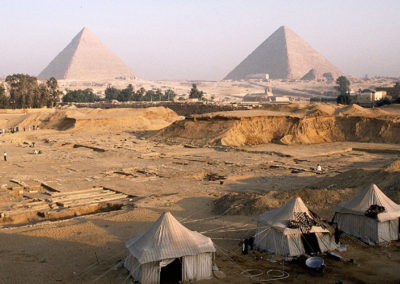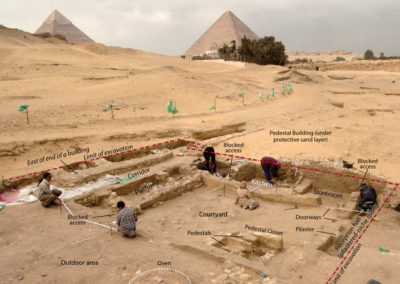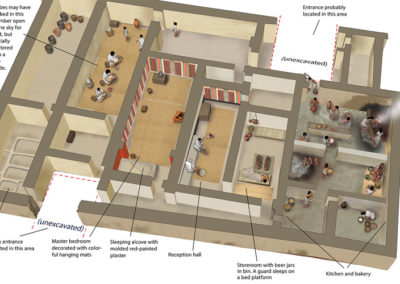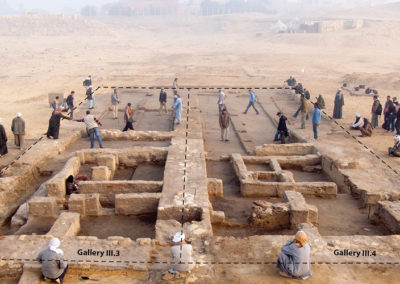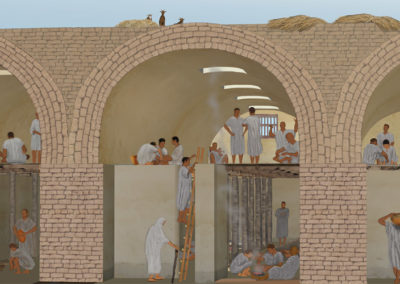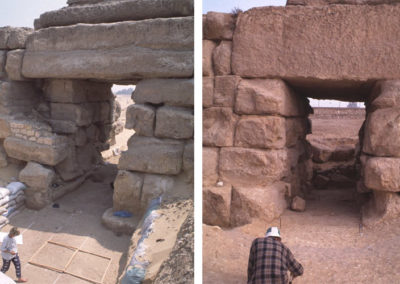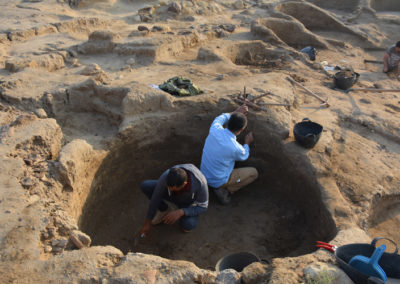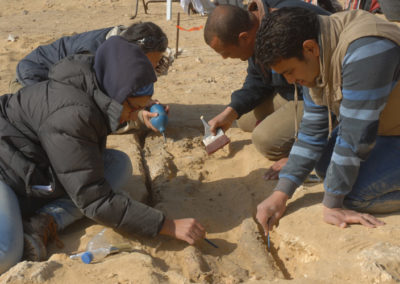The Lost City of the Pyramids
(Heit el-Ghurab)
Era
4th Dynasty, Old Kingdom
Location
Giza Plateau
Project Dates
1988 – present
Previous Excavators
None
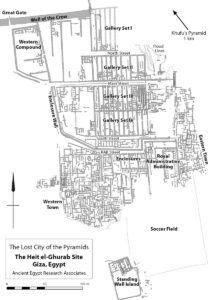
Lost City of the Pyramids site
Building the pyramids of Giza was no small matter. In the past most people who asked “How were the pyramids built?” focused on hauling and hoisting limestone, but we knew that far more went into the building of the pyramids. In the 1980s Mark Lehner began to ask himself where was the “construction site trailer” and workshops for the building site? And where were all the people — the administrators overseeing the work, the managers, craftsmen, cooks, and workers? In other words, where was the pyramid city? At other Egyptian monumental structures, archaeologists had found nearby settlements that were the base of operations for the construction projects, but no one had ever discovered where the Giza pyramid builders lived.
In December 1988, we began excavating a previously unknown site 400 meters south of the Sphinx that was near a monumental stone wall known in Arabic as Heit el-Ghurab (or “Wall of the Crow” in English). The 4th Dynasty settlement we discovered here proved to be an urban settlement that sprawled across more than 7 hectares (over 17 acres). Purpose-built by the crown, this city served as the base of operations for constructing the great pyramid complexes of kings Menkaure, Khafre, and probably Khufu. Its large population of laborers, craftsmen, managers, and administrators all directly or indirectly worked toward the single goal of erecting their king’s eternal home.
This vast town not only housed the workers who built the pyramid complexes, but also those who sustained the town and its workforce. Here craftsmen made statues and furnishings for the temples, as well as the tools and equipment for actually creating the mortuary structures, while support staff worked to provide the town with food and basic supplies. The town’s streets and alleyways were lined with craft workshops, industrial yards, bakeries, commissaries, kitchens, warehouses, small houses, and stately homes/offices for site administrators.
Raw materials from across Egypt flowed into the site for building, furnishing, and decorating the pyramid complexes and for producing the workforce’s food, clothes, shelter, tools, and equipment. During the annual Nile inundation, these materials were ferried by boat to the town’s doorstep on long extinct waterways, while at other times they were hauled there by men and animals. Massive royal silos stood in a large compound where the grain was distributed to create the beer and bread used to help feed this massive workforce.
With the completion of the Menkaure’s pyramid, this large and busy settlement was decommissioned and demolished. Tools, equipment, and supplies still of use were carried away, while timbers and mudbricks were pulled out to be reused elsewhere, leaving walls and roofs to collapse. The fact that this site was in use for such a short time period makes it invaluable for us as a time capsule of the pyramid builders.
Since discovering the site, AERA has been clearing and excavating targeted areas to determine the layout and functions of the settlement. A major goal is to understand how pyramid-building—marshaling and coordinating a workforce and goods on a massive scale—contributed to the development of the Egyptian state, one of the first in the world. A construction project on this scale had never been undertaken before.
Lost City of the Pyramids Photogallery
A reconstruction of the ancient monuments, settlements and waterways of the Giza Plateau during the 4th Dynasty.
The Lost City site during the 2000 field season. Much of the work that year involved clearing a massive blanket of overburden that covered the site. This is visible as the “cliffs” at the edge of the excavations.
An annotated photo of the excavations at area AA-South during the 2015 field season showing how different areas of the building were used. Note how some doorways were blocked when the house was remodeled.
A 3D reconstruction of House Unit 1 in the Western Town. The core of the house, the master bedroom and reception hall, are surrounded by spaces most likely used for storage and work. In this view scribes are shown at work, while food is prepared in the kitchen.
These two galleries (III.3 & III.4) are divided by a massive wall that runs between them. The areas in the foreground may have served as a house, perhaps for an overseer.
The galleries may have originally been covered with great barrel vaults as shown in this reconstruction. Here the front wall has been stripped away to show the lofts nestled under the vaults and people (and their animals) at work on two levels and the roof.
Two views of archaeologists at work at the Great Gate that leads through the Wall of the Crow into the Lost City.
Selected Bibliography
2024. Lehner, Mark. “Pyramid Harbors at Giza.” Egyptian Riverine Harbours: Proceedings of the Symposium Held at IFAO, Cairo (15th–18th September 2019). Edited by M. Yoyotte, I. Forstner-Müller, and H. Willems, Bibliothèque d’Étude 188, Cairo: Institut français d’archéologie orientale. Pages 367–400.
2024. Redding, Richard. A View from the Herd: Cattle, Sheep, Goats, and Pigs in Pharaonic Egypt, A Primer for Egyptologists and Archaeologists. Archaeobiology 5. Bristol, CT: Lockwood Press.
2024. “Field Lab: Old and New.” AERA Annual Report 2023–2024, pages 10-11.
2024. Old Kingdom Technology (with Dr. Martin Odler),” The History of Egypt Podcast. June 20, 2024.
2024. “Kemet, the Black Land: Agriculture in Ancient Egypt with Professor Claire Malleson,” Afterlives of Ancient Egypt with Kara Cooney Podcast, Episode 78. February 26, 2024.
2023. Myhrvold, Daphne, Ben Brazely, and Dan Jones. “An Alabaster Workshop for a Pyramid City.” AERAGRAM vol 24 no 1-2, pages 2-5.
2023. Malak, Emmy, Samar Ibrahim, and Ali Witsell. “A Special(ist) Story: Stone Craftsmen in Enclosure 1.” AERAGRAM vol 24 no 1-2, pages 6-10.
2023. Witsell, Ali. “E1 Clay Sealings.” AERAGRAM vol 24 no 1-2, pages 11-12.
2023. Witsell, Ali. “Sealingspalooza 2023: Surprises from the Backlog.” AERAGRAM vol 24 no 1-2, pages 13-15.
2023. Almansa-Villatoro, Victoria. “A Very 4th Dynasty House: Two Shepsekaf Sealings from House Unit 3.” AERAGRAM vol 24 no 1-2, pages 16-19.
2023. Hainline, Brendan H. “Hetepheres, but Probably Not *That* Hetepheres: The First Woman at HeG.” AERAGRAM vol 24 no 1-2, pages 19-21.
2023. Myhrvold, Daphne. “Something Great.” AERAGRAM vol 24 no 1-2, pages 22-28.
2023. Lehner, Mark. “President’s Message: A Huge Reveal AERA 2022-2023.” AERA Annual Report 2022–2023, pages 3–4.
2023. “Field Work 2022-2023.” AERA Annual Report 2022–2023, pages 6–9.
2023. “Field Lab Discoveries, Learning, Insights.” AERA Annual Report 2022–2023, pages 12–13.
2023. “Sealingspalooza.” AERA Annual Report 2022–2023, pages 14–15.
2023. Lehner, Mark. “Giza Plateau Mapping Project.” Oriental Institute 2022-2023 Annual Report. Edited by Theo van den Hout. Chicago: University of Chicago Oriental Institute, pages 39-47.
2023. Lehner, Mark. “Combinatorial Evolution and Heterogeneous Cohabitation at the Giant Pyramids.” Comparing Urban Heterogeneity, Journal of Urban Studies 8. Edited by R. Raja and S. M. Sindbæk, Turnhout: Brepols. Pages 21–46.
2022. Lehner, Mark. “Sensory Experience and Social Space at Heit el-Ghurab, the Giza Pyramid Builders’ Settlement.” Daily Life in Ancient Egyptian Settlements. SDAIK 47. Edited by J. Sigl, Wiesbaden: Harrossowitz. Pages 131–149.
2022. “Silos 2022: End Game at Heit el-Ghurab?” AERAGRAM vol 23 no 1-2, pages 2-5.
2022. “A Tale of Two City Districts.” AERAGRAM vol 23 no 1-2, pages 6-9.
2022. Redding, Richard. “Showdown at the OK Corral! Testing the Hypothesis.” AERAGRAM vol 23 no 1-2, pages 10-11.
2022. Odler, Martin, and Jiří Kmošek. “Copper at Giza: Analyses Tell Stories.” AERAGRAM vol 23 no 1-2, pages 12-17.
2022. Lehner, Mark. “Water from Below, Water from Above.” AERAGRAM vol 23 no 1-2, pages 28-31.
2022. Witsell, Ali, and David Jeřábek. “Artifact of the Issue: Sealing 2760.” AERAGRAM vol 23 no 1-2, page 32
2022. “Field Work 2021-2022.” AERA Annual Report 2021–2022, pages 4–5.
2022. Lehner, Mark. “Giza Plateau Mapping Project.” Oriental Institute 2021-2022 Annual Report. Edited by Theo van den Hout. Chicago: University of Chicago Oriental Institute, pages 45-50.
2022. Malak, Emmy, Claire Malleson, and Ali Witsell. Ancient Egypt Research Associates’ Object Typology. Boston: Ancient Egypt Research Associates.
2022. Tallet, Pierre, and Mark Lehner. The Red Sea Scrolls: How Ancient Papyri Reveal the Secrets of the Pyramids. London: Thames & Hudson.
2022. Weiss, Daniel. “Journeys of the Pyramid Builders.” Archaeology July/August.
2021. Witsell, Ali. “Stamp Seals from the Heit el-Ghurab in the Time of Khafre and Menkaure.” AERAGRAM vol 22 no 1-2, page 36.
2021. “Heit el-Ghurab Ties to Kromer’s Dump.” AERAGRAM vol 22 no 1-2, page 5.
2021. Lehner, Mark. “Soccer Field Sondages, Palace Promises.” AERAGRAM vol 22 no 1-2, pages 2–10.
2020. Lehner, Mark. “Lake Khufu: On the Waterfront at Giza Modelling Water Transport Infrastructure at Dynasty IV Giza.” In Profane Landscapes, Sacred Spaces. Edited by Miroslav Bárta and Jiri Janák. Sheffield: Equinox. Pages 191–292.
2020. Lehner, Mark. “Merer and the Sphinx.” In Guardian of Ancient Egypt: Studies in Honor of Zahi Hawass vol II. Edited by Janice Kamrin, Miroslav Bárta, Salima Ikram, Mark Lehner, and Mohamed Megahed. Prague: Charles University, Faculty of Arts. Pages 895–925.
2019. Lehner, Mark. “Neighborhood to National Network: Pyramid Settlements of Giza. Archaeological.” Papers of the American Anthropological Association vol. 30, issue 1: Excavating Neighborhoods, A Cross Cultural Exploration (Special issue July). Pages 20–38.
2019. Sowada, Karin. “Foreign Trade and Heit el-Ghurab.” AERAGRAM vol 20 no 2, pages 22–23.
2019. Odler, Martin and Jiri Kmosek. “Copper at Giza: The Latest News.” AERAGRAM vol 20 no 2, pages 11–17.
2019. Sousa, Eleuterio Luther. “Old Bones Viewed with New Methods: Did Giza Butchers Use Copper Knives.” 2019. AERAGRAM vol 20 no 1, pages 22–23.
2019. Hart, Elizabeth. “Freelance Farmers at HeG?” AERAGRAM vol 20 no 1, pages 16–21.
2019. Malleson, Claire. “Feeding the Forces, Providing for the Pyramid Builders.” RAWI, Egypt’s Heritage Review issue 10, pages 24–27.
2019. Everett, David. “Reading Seeds. Giza Botanical Database Spreads Knowledge Worldwide.” Compiled from reports by Claire Malleson. Scribe Magazine, Fall, pages 8–13.
2018. Hitchens, S. A. “Dressing the Pyramids in Cloth and Cordage: Spinning and Weaving at the Pyramids.” AERAGRAM vol 19 no 1, pages 12–15.
2018: Malleson, Claire and Rebekah Miracle (Editors). “Giza Botanical Database”. Released: 2018-10-22. Open Context. https://doi.org/10.6078/M7JH3J99
2017. Yahata, Manami. “A Roof Over Their Heads.” AERAGRAM vol 18 no 1, pages 8–12.
2017. Malleson, Claire. “The Logistics of Bread Production in Old Kingdom Egypt: A Nutritional Perspective,” In Exploring the Materiality of Food ‘Stuffs’: Transformations, Symbolic Consumption and Embodiments. Edited by Louise Steel and Katharina Zinn. Oxon and New York: Routledge. Pages 131–151.
2016. “Season 2016: Exploring a High Official’s Office-Residence.” AERAGRAM vol 17 no 1–2, pages 2–7.
2016. Wetterstrom, Wilma. “How Was ES2 Roofed? Modeling in 3D.” AERAGRAM vol 17 no 1-2, p 8–9.
2016. “From the Giza Field Lab: Unique Finds in a High Official’s Office-Residence.” AERAGRAM vol 17 no 1-2, p 10–11.
2016. Lehner, Mark. “The Giza Plateau Mapping Project,” In The 2015–2016 Annual Report. Edited by Gil J. Stein. University of Chicago, Oriental Institute, pages 82–99.
2016. “Research – Food Storage, Food Preparation: Standing Wall Island.” AERA Annual Report 2015–2016, pages 7–8.
2016. Redding, Richard. “The Vertebrate Fauna from the Excavations at Kom el-Hisn, Giza, and Other Sites.” In Kom el-Hisn (Ca. 2500–1900 BC), An Ancient Settlement in the Nile Delta of Egypt. Edited by Robert J. Wenke, Richard W. Redding, and Anthony J. Cagle. Atlanta: Lockwood Press. Pages 139–203.
2016. Lehner, Mark. “The Name and Nature of the Heit el-Ghurab Old Kingdom Site: Worker’s Town, Pyramid Town, and the Port Hypothesis.” In The Pyramids Between Life and Death. Proceedings of the Workshop held at Uppsala University Uppsala, May 31st to June 1st, 2012. Edited by Irmgard Hein, Nils Billing, and Erika Meyer-Dietrich. Uppsala: Uppsala University. Pages 99–160.
2016. Malleson, Claire, and Mary Anne Murray. “Archaeobotany of the Giza Plateau.” In Science in the Study of Ancient Egypt, ed. by S. Zakrzewski, A. Shortland, and J. Rowland, New York and London: Routledge, 2016, pages 104–107.
2015. “The Pedestal Puzzle.” AERAGRAM vol 16 no 2, page 22.
2015. “Another Official’s House Emerges in Season 2015,” AERAGRAM vol 16 no 2, pages 18-21.
2015. Lehner, Mark. “Discovery 2015: House of a High Official.” AERAGRAM vol 16 no 1, pages 2–7.
2015. “The Gallery Complex Gives Up Some of Its Secrets.” 2015. AERAGRAM vol 16 no 1, pages 12–16.
2015. Redding, Richard. “The Pig and the Chicken in the Middle East: Modeling Human Subsistence Behavior in the Archaeological Record Using Historical and Animal Husbandry Data.” Journal of Archaeological Research 23, pages 325–368.
2015. “Research – Excavations: Area Standing Wall Island (SWI), Area AA-South (AA-S) .” AERA Annual Report 2014–2015, pages 5–6.
2015. Lehner, Mark. “The Giza Plateau Mapping Project,” In The 2014–2015 Annual Report. Edited by Gil J. Stein. University of Chicago, Oriental Institute, pages 74–96.
2015. Lehner, Mark. “Labor and the Pyramids. The Heit el-Ghurab ‘Workers Town’ at Giza.” In Labor in the Ancient World. Edited by Piotr Steinkeller and Michael Hudson. Dresden: ISLET-Verlag. Pages 397–522.
2015. Lehner, Mark. “Shareholders: The Menkaure Valley Temple Occupation in Context.” In Towards a New History for the Egyptian Old Kingdom: Perspectives on the Pyramid Age. Harvard Egyptological Studies 1. Edited by Peter der Manuelian and Thomas Schneider. Leiden and Boston: Brill.Pages 227–314.
2015. Kawae, Yukinori. Excavating the Pyramid Town. Tokyo: Shinchosha Publishing Co.
2015. Kamel, Mohsen. The Ground Plan as a Tool for the Identification and Study of Houses in an Old Kingdom Special-Purpose Settlement at Heit el-Ghurab, Giza. PhD dissertation, University of California, Los Angeles.
2015. Sadarangani, Freya, and Alexandra Witsell (editors). Settlement and Cemetery at Giza: Papers from the 2010 AERA-ARCE Field School. Boston: Ancient Egypt Research Associates. Pages 15-236.
2014. “Season 2015: Doing Science at Giza.” AERAGRAM vol 15 no 1 & 2, pages 10–13.
2014. Nolan, John. “A Change of Address: Funerary Workshop Priests Move to New Quarters.” AERAGRAM vol 15 no 1 & 2, pages 29–31.
2014. Witsell, Ali. “A Return to Area AA: Informal Seals and Sealings of the Heit el-Ghurab.” AERAGRAM vol 15 no 1 & 2, pages 32–34.
2014. Lehner, Mark. “On the Waterfront: Canals and Harbors in the Time of Giza Pyramid-Building.” AERAGRAM vol 15 no 1 & 2, pages 14–23.
2013. “Dining in a High-Status House:The Good Life, 4th Dynasty Style.” AERA Annual Report 2012–2013, pages 8–9.
2013. Lehner, Mark. “The Heit el-Ghurab Site Reveals a New Face: The Lost Port City of the Pyramids.” AERAGRAM vol 14 no 1, pages 2–7.
2013. Malleson, Claire. “Egypt’s Oldest Olive Pit Reconsidered: A Case of Mistaken Identity?” AERAGRAM vol 14 no 1, page 24.
2013. Redding, Richard. “A Tale of Two Sites: Old Kingdom Subsistence Economy and the Infrastructure of Pyramid Construction.” In Archaeozoology of the Near East X: Proceedings of the Tenth International Symposium on the Archaeozoology of South-Western Asia and Adjacent Areas. Edited by B. de Cupere, V. Linseele, and S. Hamilton-Dyer. Lueven: Peeters. Pages 307–322.
2012. Malleson, Claire. “Egypt’s Oldest Olive Pit at the Lost City of the Pyramid Builders.” AERAGRAM vol 13 no 2, page 24.
2012. Nolan, John. “Fifth Dynasty Renaissance at Giza.” AERAGRAM vol 13 no 2, pages 2–3.
2012. “2012 Field Season Excavations: Gallery III.3.” AERA Annual Report 2011–2012, pages 14–15.
2012. “Archaeological Science: Hippo Hip and Olive Pit.” AERA Annual Report 2011–2012, pages 20–21.
2011. “Excavations: the Heit el-Ghurab Site.” In Giza Occasional Papers, Vol 5: Season 2009 Preliminary Report. Edited by Mark Lehner. Boston: Ancient Egypt Research Associates. Pages 9-12, 93-145.
2011. “Specialist Reports.” In Giza Occasional Papers, Vol 5: Season 2009 Preliminary Report. Edited by Mark Lehner. Boston: Ancient Egypt Research Associates. Pages 147-216.
2011. “Stews, Meat and Marrow: Extracting Protein and Fat for the Lost City.” AERAGRAM vol 12 no 2, pages 13–15.
2011. Redding, Richard. “The OK Corral: Standing Wall Mystery, Solved.” AERAGRAM vol 12 no 1, pages 2-5.
2011. “The OK Corral.” AERA Annual Report 2010–2011, pages 14–17.
2011. “Double-Decker Dorm? Reconstructing the Galleries.” AERAGRAM vol 11 no 2, pages 7–9.
2011. “On the Cusp of a New Dynasty: Khentkawes and Uskekaf.” AERAGRAM vol 11 no 2, pages 10-12.
2011. Wodzinska, Anna, and Mary Ownby. “Tentative Remarks on Levantine Combed Ware from Heit el-Ghurab, Giza.” In Egypt and the Near East – The Crossroads. Edited by Jana Mynárová. Prague:Czech Institute of Egyptology, Charles University. Pages 285–295.
2011. Wodzinska, Anna. “Potmarks of the Early Dynastic Buto and the Old Kingdom Giza. Their Occurrence and Economic Significance.” In Egypt at its Origin 3. Orientalia Lovaniensia Analecta 205. Edited by R. Friedman and P. N. Fiske. Leuven: Peeters Publishers. Pages 1073–1096.
2011. Tavares, Ana. “Village, Town and Barracks: A Fourth Dynasty Settlement at Heit el-Ghurab, Giza.” In Old Kingdom: New Perspectives, Egyptian Art and Archaeology 2750–2150 BC. Edited by N. and H. Strudwick. Oxford: Oxbow.
2011. Tavares, Ana, and Sabine Laemmel.“Some Post-Old Kingdom Pottery from Giza.” In Under The Potter’s Tree, Studies on Ancient Egypt Presented to Janine Bourriau on the Occasion of her 70th Birthday. Lovaniensia Analecta Orientalia 204. Edited by D. Aston, B. Bader, C. Gallorini, P. Nicholson, and S. Buckingham. Leuven: Peeters.
2011. Wodzinska, Anna. “The Ancient Egypt Research Associates Settlement Site at Giza: The Old Kingdom Ceramic Distribution.” In Old Kindgom: New Perspectives, Egyptian Art and Archaeology 2750–2150 BC. Edited by N. and H. Strudwick. Oxford: Oxbow.
2010. Wodzinska, Anna. A Manual of Egyptian Pottery, volume 2: Naqada III–Middle Kingdom. Boston: Ancient Egypt Research Associates.
2010. Lehner, Mark. “Villages and the Old Kingdom.” In Egyptian Archaeology. Edited by Willeke Wendrich. Chicester: Wiley-Blackwell. Pages 85–101.
2010. Lehner, Mark, and Ana Tavares. “Walls, Ways and Stratigraphy: Signs of Social Control in an Urban Footprint at Giza.” In Cities and Urbanism in Ancient Egypt: Papers from a Workshop in November 2006 at the Austrian Academy of Sciences. Edited by Manfred Bietak, Ernst Czerny, and Irene Forstner-Müller. Vienna: Österreichischen Akademie der Wissenschaften. Pages 171–216.
2009. “The Two Towns: Season 2009 at Giza: Heit el-Ghurab (HeG): The Lost City Site.” AERA Annual Report 2008–2009, pages 4–10.
2009. “Excavations.” In Giza Occasional Papers, Vol 3: Seasons 2006-2007. Preliminary Report. Edited by Mark Lehner, Mohsen Kamel and Ana Tavares. Boston: Ancient Egypt Research Associates. Pages 7 – 96.
2009. Lehner, Mark. “Capital Zone Walk-About 2006: Spot Heights on the Third Millennium Landscape.” In Giza Occasional Papers, Vol 3: Seasons 2006-2007. Preliminary Report. Edited by Mark Lehner, Mohsen Kamel and Ana Tavares. Boston: Ancient Egypt Research Associates. Pages 97-151.
2009. Dash, Glen. “2006 Geophysical Season at Giza: A Ground-Penetrating Radar Study.” In Giza Occasional Papers, Vol 3: Seasons 2006-2007. Preliminary Report. Edited by Mark Lehner, Mohsen Kaeml and Ana Tavares. Boston: Ancient Egypt Research Associates. Pages 152-157.
2009. “Going to the Dogs: Giza’s First Canine Burials Discovered.” AERAGRAM vol 10 no 2, page 14.
2009. “Daily Life of the Pyramid Builders.” AERAGRAM vol 10 no 1, pages 8–14.
2009. Lehner, Mark. “Enigma of the Pedestal Building: Hypotheses: Desert refrigerator? Malting Machine? Or both?” In Beyond the Horizon: Studies in Egyptian Art, Archaeology and History in Honour of Barry J. Kemp. Edited by Salima Ikram and Aidan Dodson. Cairo: Publications of the Supreme Council of Antiquities. Pages 189–222.
2009. Wodzinska, Anna. “Potmarks from Early Dynastic Buto and Old Kingdom Giza. Their Occurrence and Economic Significance.” British Museum Studies in Ancient Egypt and Sudan vol 13, pages 239–261.
2009. Lehner, Mark, Mohsen Kamel and Ana Tavares. Giza Occasional Papers, Vol 1: Season 2004. Preliminary Report. Boston: Ancient Egypt Research Associates.
2008. Gerisch, Rainer, Wilma Wetterstrom, and Mary Anne Murray. “Egypt’s Oldest Olive.” AERAGRAM vol 9 no 2, pages 3.
2008. Tavares, Ana. “Small Finds, Big Results: Inconspicuous Stones a Key to an Ancient Industry.” AERAGRAM vol 9 no 2, pages 4–5.
2008. “Under the Microscope: Life Stories from the Pyramid City Unfold.” AERA Annual Report 2007–2008, pages 16–19.
2008. Nolan, John, and Amanda Pavlick. “Impressions of the Past: Seals and Sealings from Pottery Mound.” AERAGRAM vol 9 no 1, pages 2–4.
2008. Wetterstrom, Wilma, and Ana Tavares. “Lost City Site, Flooded.” AERAGRAM vol 9 no 1, pages 5–7.
2008. Wodzinska, Anna “White Carinated Bowls from Giza and Dating of the Giza Plateau Mapping Project Site.” In Chronology and Archaeology of Egypt. The late Fourth and the Third Millennium BC, Proceedings of the Conference Held in Prague (June 11–14 2007). Edited by Hana Vamazalova and Miroslav Bárta, Prague: Czech Institute of Egyptology. Pages 111-23.
2007. “Enigma of the Pedestals: 2006-2007 Field Season.” AERAGRAM vol 8 no 2, pages 1–3.
2007. Redding, Richard. “Treasures from a High Class Dump.” AERAGRAM vol 8 no 2, pages 6–7.
2007. Lehner, Mark, Günter Heindl, Ed Johnson, Ashraf Abd al-Aziz, and Ana Tavares. “Giza Plateau Conservation Pilot Study, 2005–2006: Eastern Town House. “ American Research Center in Egypt Bulletin no. 192, pages 16–23.
2007. Lehner, Mark, and Freya Sadarangani. “Beds for Bowabs in a Pyramid City.” In The Archaeology and Art of Ancient Egypt: Essays in Honor of David B. O’Connor, vol II. Annales du Service des Antiquites De L’Égypte No. 36. Edited by Zahi A. Hawass and Janet Richards. Cairo: Conseil Supreme des Antiquités De L’Égypte. Pages 39–81.
2006. Lehner, Mark, and Wilma Wetterstrom (editors). Giza Reports: The Giza Plateau Mapping Project, Volume 1. Boston: Ancient Egypt Research Associates.
2006. Lehner, Mark, Mohsen Kamel and Ana Tavares. Giza Occasional Papers, Vol 2: Seasons 2006-2007. Preliminary Report. Boston: Ancient Egypt Research Associates.
2006. “Conservation Pilot Project: A Humble Compound Reborn.” AERAGRAM vol 8 no 1, pages 8–9.
2006. “Rescue Archaeology: Deep Gouge Offers Clues to a High Wall.” AERAGRAM vol 8 no 1, pages 10–12.
2006. “Three Roads Diverged.” AERAGRAM vol 8 no 1, pages 14–15.
2004. “Season 2004: A New Neighborhood.” AERAGRAM vol 7 no 2, pages 1–3.
2004. “Behind Mudbrick Walls: Life in an Eastern Town Home.” AERAGRAM vol 7 no 2, pages 6–7.
2004. “The Hidden Industry: Weaving at the Workes’ Settlement.” AERAGRAM vol 7 no 2, pages 10–11.
2004. “Of Gangs and Graffitti: How Ancient Egyptians Organized their Labor Force.” AERAGRAM vol 7 no 1, pages 11–13.
2004. “Life Stories of the Pyramid City Unfold.” AERAGRAM vol 6 no 2, pages 1, 4–5.
2003. “A Non-Excavation Season 2003 Dig: On the Trail of the Lost City.” AERAGRAM vol 6 no 2, page 6.
2002. “The Gift That Worked: The Millenium Project.” AERAGRAM vol 6 no 1, page 1–16.
2001. “Footprint of the State! The City of the Pyramid Buiders.” AERAGRAM vol 5 no 1, page 1–2.
2001. “Up Against the Wall: The Wall of the Crow.” AERAGRAM vol 5 no 1, page 6–10.
2001. Lehner, Mark. “Great Giza Galleries: Year Two of the Millennium Project.” AERAGRAM vol 4 no 2, pages 1–2, 6–7.
2000. Lehner, Mark. “Absolutism and Reciprocity in Ancient Egypt.” In The Breakout: The Origins of Civilization. Edited by Martha Lamberg-Karlovsky. Cambridge: Harvard University. Pages 69–97.
2000. Lehner, Mark. “Lost city of the Pyramids.” Egypt Revealed, Fall, pages 42–57.
2000. Lehner, Mark. “The First Year of the Millennium Project: Unveiling a Royal Plan.” AERAGRAM vol 4 no 1, pages 1–2, 6–8.
2000. Lehner, Mark. “Interim Report From the Field: A Royal Plan Emerges.” AERAGRAM vol 3 no 2, pages 1, 6–10.
1999. Lehner, Mark. “The Millennium Project: Marathon Excavation to Capture Area A.” AERAGRAM vol 3 no 1, pages 1–3.
1999. Lehner, Mark. “The Older Phase: A Glimpse of the Early Pyramid Age at Giza.” AERAGRAM vol 3 no 1, pages 8–11.
1998. Lehner, Mark. “The Big Leap Forward: What Did We Get?” AERAGRAM vol 2 no 2, pages 1–11.
1998. Lehner, Mark. “1998 Excavations.” AERAGRAM vol 2 no 1, pages 7–9.
1997. Lehner, Mark, and Wilma Wetterstrom. “The 1997 Field Season.” AERAGRAM vol 1 no 2, pages 1–9.
1997. Lehner, Mark. End of Field Season Full Report. PBS Nova Online Adventure.
1997. Lehner, Mark. “Builders of the Pyramids.” Archaeology, January/February, pages 31–35, 37–38.
1997. Lehner, Mark. “Replicating an Ancient Bakery.” Archaeology, January/February, page 36.
1996. “Pyramid Age Bakery Reconstructed.” AERAGRAM vol 1 no 1, pages 6–7.
1996. “The 1995 Field Season.” AERAGRAM vol 1 no 1, page 8.
1992. Lehner, Mark. “Excavations at Giza 1988-1991: The Location and Importance of the Pyramid Settlement.” Oriental Institute News and Notes, pages 1–9.
1990. Chazan, Michael, and Mark Lehner. “An Ancient Analogy: Pot Baked Bread in Ancient Egypt and Mesopotamia.” Paléorient vol 16 no 2, pages 21–35.




